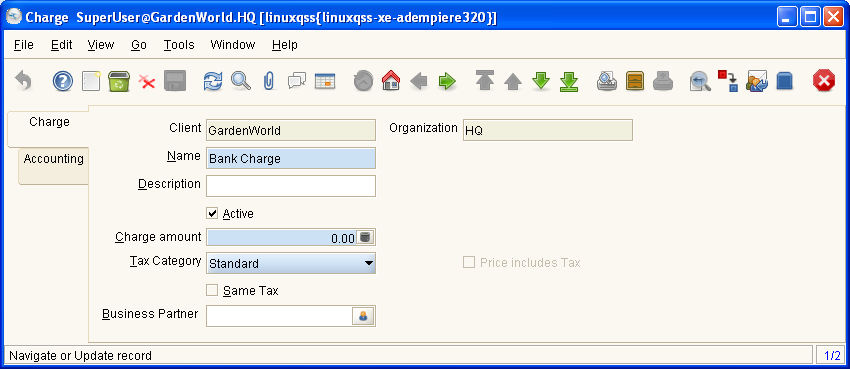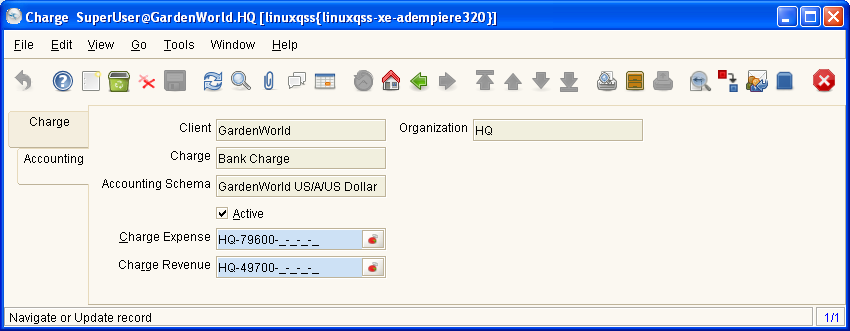ManPageW Charge
Enjoy it, and help to fill it! But please, always respecting copyright.
Please write your contributions under the Contributions Section
Window: Charge
Description : Maintain Charges
Help : The Charges Window defines the different charges that may be incurred. These can include Bank Charges, Vendor Charges and Handling Charges.
Tab: Charge
Description : Charge
Help : The Charge Tab defines the unique charges that may be associated with a document. The optional Business Partner allows to create Purchase Orders from Requisitions.
Table Name : C_Charge
Fields
| Name | Description | Help | Technical Data |
|---|---|---|---|
| Client | Client/Tenant for this installation. | A Client is a company or a legal entity. You cannot share data between Clients. Tenant is a synonym for Client. | AD_Client_ID
NUMBER(10) TableDir |
| Organization | Organizational entity within client | An organization is a unit of your client or legal entity - examples are store, department. You can share data between organizations. | AD_Org_ID
NUMBER(10) TableDir |
| Name | Alphanumeric identifier of the entity | The name of an entity (record) is used as an default search option in addition to the search key. The name is up to 60 characters in length. | Name
NVARCHAR2(60) String |
| Description | Optional short description of the record | A description is limited to 255 characters. | Description
NVARCHAR2(255) String |
| Active | The record is active in the system | There are two methods of making records unavailable in the system: One is to delete the record, the other is to de-activate the record. A de-activated record is not available for selection, but available for reports.
There are two reasons for de-activating and not deleting records: (1) The system requires the record for audit purposes. (2) The record is referenced by other records. E.g., you cannot delete a Business Partner, if there are invoices for this partner record existing. You de-activate the Business Partner and prevent that this record is used for future entries. |
IsActive
CHAR(1) YesNo |
| Charge amount | Charge Amount | The Charge Amount indicates the amount for an additional charge. | ChargeAmt
NUMBER Amount |
| Tax Category | Tax Category | The Tax Category provides a method of grouping similar taxes. For example, Sales Tax or Value Added Tax. | C_TaxCategory_ID
NUMBER(10) TableDir |
| Price includes Tax | Tax is included in the price | The Tax Included checkbox indicates if the prices include tax. This is also known as the gross price. | IsTaxIncluded
CHAR(1) YesNo |
| Same Tax | Use the same tax as the main transaction | The Same Tax checkbox indicates that this charge should use the same tax as the main transaction. | IsSameTax
CHAR(1) YesNo |
| Business Partner | Identifies a Business Partner | A Business Partner is anyone with whom you transact. This can include Vendor, Customer, Employee or Salesperson | C_BPartner_ID
NUMBER(10) Search |
Tab: Accounting
Description : Charge Accounting
Help : The Accounting Tab defines the accounting parameters used for transactions including a charge or charges.
Table Name : C_Charge_Acct
Fields
| Name | Description | Help | Technical Data |
|---|---|---|---|
| Client | Client/Tenant for this installation. | A Client is a company or a legal entity. You cannot share data between Clients. Tenant is a synonym for Client. | AD_Client_ID
NUMBER(10) TableDir |
| Organization | Organizational entity within client | An organization is a unit of your client or legal entity - examples are store, department. You can share data between organizations. | AD_Org_ID
NUMBER(10) TableDir |
| Charge | Additional document charges | The Charge indicates a type of Charge (Handling, Shipping, Restocking) | C_Charge_ID
NUMBER(10) TableDir |
| Accounting Schema | Rules for accounting | An Accounting Schema defines the rules used in accounting such as costing method, currency and calendar | C_AcctSchema_ID
NUMBER(10) TableDir |
| Active | The record is active in the system | There are two methods of making records unavailable in the system: One is to delete the record, the other is to de-activate the record. A de-activated record is not available for selection, but available for reports.
There are two reasons for de-activating and not deleting records: (1) The system requires the record for audit purposes. (2) The record is referenced by other records. E.g., you cannot delete a Business Partner, if there are invoices for this partner record existing. You de-activate the Business Partner and prevent that this record is used for future entries. |
IsActive
CHAR(1) YesNo |
| Charge Expense | Charge Expense Account | The Charge Expense Account identifies the account to use when recording charges paid to vendors. | Ch_Expense_Acct
NUMBER(10) Account |
| Charge Revenue | Charge Revenue Account | The Charge Revenue Account identifies the account to use when recording charges paid by customers. | Ch_Revenue_Acct
NUMBER(10) Account |

